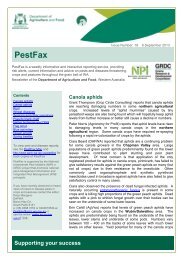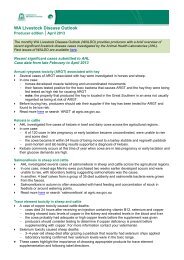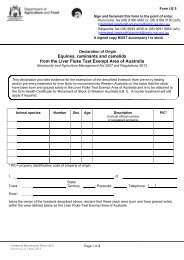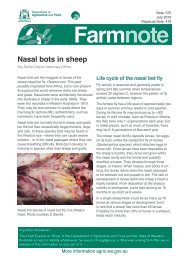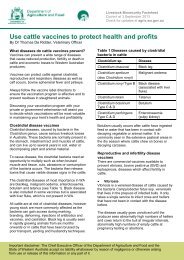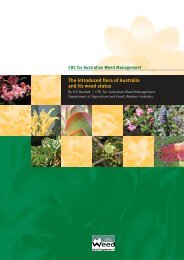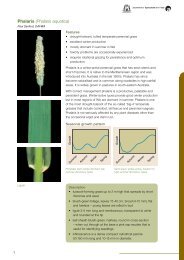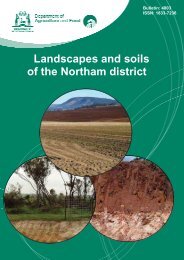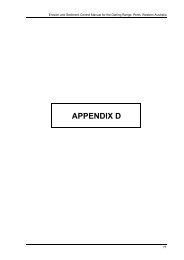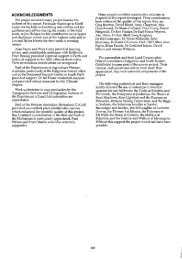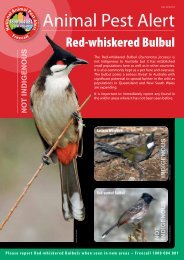Cape tulips - Department of Agriculture and Food
Cape tulips - Department of Agriculture and Food
Cape tulips - Department of Agriculture and Food
Create successful ePaper yourself
Turn your PDF publications into a flip-book with our unique Google optimized e-Paper software.
<strong>Cape</strong> <strong>tulips</strong><br />
Chris Hawkins, Moora District Offi ce <strong>and</strong> S<strong>and</strong>y Lloyd, South Perth<br />
What you need to know about <strong>Cape</strong> tulip<br />
<strong>Cape</strong> tulip is the common name applied to two toxic<br />
plants native to South Africa. These are the one-leaf<br />
<strong>Cape</strong> tulip (Moraea fl accida, formerly known as Homeria<br />
fl accida) <strong>and</strong> the two-leaf <strong>Cape</strong> tulip (M. miniata, formerly<br />
known as H. miniata). Like many other serious weeds,<br />
<strong>Cape</strong> <strong>tulips</strong> were introduced to Australia as garden<br />
plants because <strong>of</strong> their attractive fl owers <strong>and</strong> hardy<br />
nature. They soon jumped the garden fence <strong>and</strong> now<br />
both are common <strong>and</strong> widespread in the south-west<br />
<strong>of</strong> Western Australia <strong>and</strong> are weeds in South Australia,<br />
Victoria <strong>and</strong> New South Wales. One-leaf <strong>Cape</strong> tulip is<br />
also found in Tasmania <strong>and</strong> New Zeal<strong>and</strong>. The genus<br />
Homeria was added to the US Federal Noxious Weeds<br />
list (http://plants.usda.gov) in May 2000.<br />
<strong>Cape</strong> <strong>tulips</strong> are members <strong>of</strong> the iris family, Iridaceae,<br />
a large family with both native <strong>and</strong> exotic species in<br />
Western Australia. Examples <strong>of</strong> other weedy species are<br />
A heavy invasion <strong>of</strong> one-leaf <strong>Cape</strong> tulip<br />
Important Disclaimer<br />
The Chief Executive Offi cer <strong>of</strong> the <strong>Department</strong> <strong>of</strong> <strong>Agriculture</strong> <strong>and</strong> <strong>Food</strong> <strong>and</strong> the State <strong>of</strong> Western Australia accept no liability<br />
whatsoever by reason <strong>of</strong> negligence or otherwise arising from the use or release <strong>of</strong> this information or any part <strong>of</strong> it.<br />
For more information visit our web site www.agric.wa.gov.au<br />
Note: 317<br />
Replaces Note 100<br />
July 2008<br />
freesia (Freesia hybrid), some gladiolus (e.g. Gladiolus<br />
caryophyllaceus <strong>and</strong> G. undulatus) <strong>and</strong> watsonias<br />
(Watsonia spp.) which are all native to South Africa.<br />
One-leaf <strong>and</strong> two-leaf <strong>Cape</strong> tulip are declared plants<br />
in Western Australia <strong>and</strong> their import into this State is<br />
regulated. Several other Moraea species have been<br />
found in Western Australia. Of these, the most common<br />
<strong>and</strong> widespread is thread iris (Moraea setifolia, formerly<br />
known as Gyn<strong>and</strong>riris setifolia) which is found from<br />
the Geraldton area to the south coast. In addition,<br />
Moraea aristata, M. fugax, M. lewisiae, M. ochroleuca,<br />
M. pavonis <strong>and</strong> M. vegetata have all been recorded as<br />
garden escapees in Western Australia. M. setifolia <strong>and</strong><br />
M. lewisiae (formerly known as Hexaglottis lewisae) are<br />
known to be poisonous, with symptoms similar to <strong>Cape</strong><br />
tulip poisoning. However, it would be wise to regard all<br />
Moraea species as toxic.
Figure 2. Flowering one-leaf <strong>Cape</strong> tulip<br />
Why <strong>Cape</strong> <strong>tulips</strong> matter<br />
Both one-leaf <strong>and</strong> two-leaf <strong>Cape</strong> <strong>tulips</strong> are serious weeds<br />
<strong>of</strong> pasture. Animals will selectively graze clovers <strong>and</strong> other<br />
more palatable species, <strong>and</strong> this allows <strong>Cape</strong> tulip to<br />
fl ourish. They contain toxic chemicals called glycosides<br />
which affect the heart. Symptoms <strong>of</strong> poisoning in cattle<br />
include loss <strong>of</strong> appetite, abdominal pain, stiffness <strong>of</strong> the<br />
hind legs, diarrhoea, general depression, <strong>and</strong> weakness<br />
that may advance to convulsions or paralysis. Death<br />
may occur within hours <strong>of</strong> consuming the plant, or<br />
over several days. At post-mortem examination there<br />
is usually evidence <strong>of</strong> gastro-enteritis, with reddening<br />
<strong>of</strong> the abomasum (true stomach), <strong>and</strong> longitudinal<br />
red striping <strong>of</strong> the caecum <strong>and</strong> terminal large bowel.<br />
The heart may show haemorrhages on the inside <strong>and</strong><br />
outside surfaces.<br />
Cattle are most commonly affected when stock<br />
unaccustomed to the plant are placed on heavily<br />
infested pastures. About a kilogram <strong>of</strong> fresh leaf material<br />
is enough to cause death overnight. Sheep are rarely<br />
affected, although they are susceptible to the toxins.<br />
Placing very hungry sheep on infested green or dry<br />
pasture may result in poisoning. The plant remains toxic<br />
Figure 4. Corm <strong>of</strong> two-leaf <strong>Cape</strong> tulip, with massed cormils. Each<br />
cormil is potentially a new plant.<br />
Figure 3. Flowering two-leaf <strong>Cape</strong> tulip<br />
even when dry, so contaminated hay can also be a<br />
problem. There is no treatment readily available. Prevent<br />
poisoning by avoiding contact with the plants. Always<br />
seek veterinary advice when livestock show unusual<br />
symptoms <strong>and</strong>/or unexplained deaths occur.<br />
<strong>Cape</strong> <strong>tulips</strong> can be diffi cult <strong>and</strong> expensive to eradicate.<br />
Some herbicides effective in controlling <strong>Cape</strong> tulip<br />
also damage pasture legumes. Research is continuing<br />
into economically viable means <strong>of</strong> control, including<br />
biological control.<br />
What to look for<br />
One-leaf <strong>Cape</strong> tulip, as the name suggests, typically<br />
has only one leaf per plant. The leaves are 1 to 2 cm<br />
wide <strong>and</strong> can be up to 1 m long. The erect fl owering<br />
stem can reach up to 60 cm in height. The fl owers are<br />
usually orange to salmon pink with a yellow centre, but<br />
occasionally plain yellow. The small brown seeds are<br />
produced in a three-valved capsule up to 5 cm long. The<br />
underground corm has a light brown fi brous covering.<br />
Two-leaf <strong>Cape</strong> tulip is very similar in appearance to oneleaf,<br />
but has 2 or 3 leaves per plant. Two-leaf <strong>Cape</strong> tulip<br />
does not produce seeds but produces a large number <strong>of</strong><br />
small cormils around the parent corm, <strong>and</strong> in the angle<br />
where the leaves join the stem. The underground corm<br />
has a hard black covering.<br />
Life history <strong>of</strong> <strong>Cape</strong> <strong>tulips</strong><br />
<strong>Cape</strong> <strong>tulips</strong> prefer heavier soils, but will grow in s<strong>and</strong>. The<br />
heaviest infestations tend to be found on clay or loam in<br />
the earliest settled areas in the Swan <strong>and</strong> Avon Valleys,<br />
though infestations extend from the Geraldton area<br />
through the south-west to Esperance <strong>and</strong> the Goldfi elds.
Figure 5. Blanket wiper technique for selective application <strong>of</strong> herbicide to <strong>Cape</strong> tulip in pasture. Note the height <strong>of</strong> wiper is above level <strong>of</strong><br />
other plants, to minimise pasture damage.<br />
<strong>Cape</strong> <strong>tulips</strong> are found on agricultural l<strong>and</strong> (especially<br />
permanent pastures), roadsides, wastel<strong>and</strong> <strong>and</strong> in<br />
remnant bushl<strong>and</strong>. The corms <strong>and</strong> cormils are spread<br />
by cultivation, <strong>and</strong> by earthworks such as road grading.<br />
They do not usually invade waterlogged sites, though<br />
both species can survive periodic inundation. <strong>Cape</strong> tulip<br />
corms <strong>and</strong> cormils can be spread by fl oodwaters.<br />
Both seeds <strong>and</strong> corms <strong>of</strong> one-leaf <strong>Cape</strong> tulip emerge<br />
in autumn after rain. Depending on the season, up to<br />
60% <strong>of</strong> corms can remain dormant in the soil. Dense<br />
infestations can have almost 7,000 corms per square<br />
metre. Flowering takes place in spring. Plants do not<br />
fl ower until they are two or three years old.<br />
Two-leaf <strong>Cape</strong> tulip has a similar life cycle, emerging<br />
in autumn <strong>and</strong> fl owering in spring. Two-leaf <strong>Cape</strong> tulip<br />
does not produce seeds but produces cormils on the<br />
stem. In dense infestations there can be up to 700,000<br />
cormils per square metre. Cormils can remain dormant<br />
for up to eight years.<br />
What you can do about <strong>Cape</strong> <strong>tulips</strong><br />
The dormancy associated with both <strong>Cape</strong> tulip species<br />
can lead to disappointment with control efforts. If a good<br />
kill is achieved in a year when many plants are dormant,<br />
there may be many more plants present the following<br />
season. Persistence is the key in reducing density <strong>of</strong><br />
<strong>Cape</strong> tulip infestations. Ask your agribusiness consultant,<br />
local Biosecurity Offi cer or l<strong>and</strong>care coordinator for<br />
assistance in preparing a weed management plan.<br />
See Farmnote 213 Control <strong>of</strong> <strong>Cape</strong> Tulip in Pasture<br />
<strong>and</strong> Farmnote 75/2005 Blanket wipers for tall weed<br />
control.<br />
Small l<strong>and</strong>holders can also contact the Small L<strong>and</strong>holder<br />
Information Service for advice on weed control, pasture<br />
management, property planning <strong>and</strong> other relevant<br />
matters. (Tel: 9733 3333, Email: small_l<strong>and</strong>holder@<br />
agric.wa.gov.au) or see www.agric.wa.gov.au <strong>and</strong><br />
search for “small l<strong>and</strong>holder”. In addition, owners <strong>of</strong><br />
small l<strong>and</strong>holdings will fi nd the free publication Bulletin<br />
4686 The L<strong>and</strong> is in your h<strong>and</strong>s a useful source <strong>of</strong><br />
information.<br />
Practice good biosecurity to avoid introducing <strong>Cape</strong><br />
tulip to your property <strong>and</strong> to avoid poisoning livestock.<br />
Take particular care to buy hay that does not contain<br />
<strong>Cape</strong> tulip or other unwanted weeds. It can be an<br />
Figure 6. Thread iris, Moraea setifolia
Figure 7. Moraea lewisiae Figure 8. Chincherinchee, Ornithogalum thyrsoides<br />
<strong>of</strong>fence to sell or transport hay or other materials<br />
containing declared pests — <strong>of</strong>fences can be reported<br />
to the nearest <strong>of</strong>fi ce <strong>of</strong> the <strong>Department</strong> <strong>of</strong> <strong>Agriculture</strong><br />
<strong>and</strong> <strong>Food</strong>.<br />
Do not allow contractors with dirty machinery to work<br />
on your property — if necessary provide a wash-down<br />
area so they can clean their equipment. If you already<br />
have <strong>Cape</strong> tulip, do not allow it to spread from your<br />
property. Learn <strong>and</strong> map where infestations are located<br />
to avoid spreading <strong>Cape</strong> tulip by cultivation. Include<br />
weed infestations in farm mapping <strong>and</strong> planning. If you<br />
can, always work from clean to dirty areas. Wash down<br />
machinery before moving it to clean areas, as <strong>Cape</strong> tulip<br />
<strong>and</strong> many other weeds are known to spread in soil. Use<br />
effective control techniques, including herbicides, to<br />
reduce the size <strong>of</strong> <strong>Cape</strong> tulip infestations.<br />
Some l<strong>and</strong>holders have expressed concern about using<br />
‘toxic’ chemicals on pastures; however, remember that<br />
<strong>Cape</strong> tulip can be deadly to livestock <strong>and</strong> the longer its<br />
control is delayed, the more it will spread.<br />
When choosing plants for your garden, avoid buying<br />
species that are toxic <strong>and</strong>/or have weed potential. Mail<br />
order catalogues may be convenient but some <strong>of</strong>fer for<br />
sale toxic weeds such as chincherinchee (Ornithogalum<br />
thyrsoides). If you have any questions about suitable<br />
garden plants for your farm, your local l<strong>and</strong>care or<br />
catchment group may be able to provide advice.<br />
082244-07/08-ID9456<br />
Copyright © Western Australian Agricultural Authority, 2008<br />
Garden-notes on weedy bulbs <strong>and</strong> garden plants <strong>and</strong><br />
Bulletin 4641 Harmful garden plants in Western Australia<br />
are available from the Pest <strong>and</strong> Disease Advisory Service<br />
(Tel. 1800 084 881). Accredited nurseries should also<br />
be able to provide advice.<br />
For identifi cation <strong>of</strong> weed specimens, please take a<br />
sample to your nearest <strong>Department</strong> <strong>of</strong> <strong>Agriculture</strong> <strong>and</strong><br />
<strong>Food</strong> <strong>of</strong>fi ce, or post it to AGWEST Plant Laboratories at<br />
Locked Bag 4, Bentley Delivery Centre WA 6983.<br />
Further reading<br />
• Everist, SL (1974) Toxic plants <strong>of</strong> Australia, Angus<br />
<strong>and</strong> Robertson. London. Revised edition 1981 (out<br />
<strong>of</strong> print).<br />
• Hussey, BMJ, Keighery, GJ, Dodd, J, Lloyd, SG <strong>and</strong><br />
Cousens, RD (2007) Western Weeds – a guide to<br />
the weeds <strong>of</strong> Western Australia, 2nd Edition, Weeds<br />
Society <strong>of</strong> WA, Perth.<br />
• Moore, J <strong>and</strong> Wheeler, J (2008) Southern Weeds <strong>and</strong><br />
their control (2nd Edition). <strong>Department</strong> <strong>of</strong> <strong>Agriculture</strong><br />
<strong>and</strong> <strong>Food</strong>.<br />
• Parsons, WT <strong>and</strong> Cuthbertson, EG (2000) Noxious<br />
Weeds <strong>of</strong> Australia. CSIRO Publishing.<br />
Two very useful webpages for weed information are the<br />
Weeds CRC webpage www.weedscrc.org.au <strong>and</strong> the<br />
Weeds Australia webpage www.weeds.org.au<br />
ISSN 0726-934X



